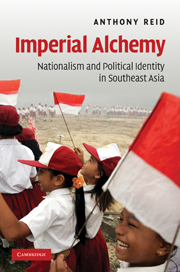1714 results in South-East Asian government, politics and policy
Frontmatter
-
- Book:
- South Korea since 1980
- Published online:
- 05 June 2012
- Print publication:
- 28 June 2010, pp i-vi
-
- Chapter
- Export citation
Dedication
-
- Book:
- South Korea since 1980
- Published online:
- 05 June 2012
- Print publication:
- 28 June 2010, pp viii-viii
-
- Chapter
- Export citation
5 - Economic Reform and the Korea–U.S. Free Trade Agreement
-
- Book:
- South Korea since 1980
- Published online:
- 05 June 2012
- Print publication:
- 28 June 2010, pp 104-128
-
- Chapter
- Export citation
7 - The South Korea–U.S. Alliance
-
- Book:
- South Korea since 1980
- Published online:
- 05 June 2012
- Print publication:
- 28 June 2010, pp 157-182
-
- Chapter
- Export citation
1 - Politics, Economics, and Foreign Relations before 1980
-
- Book:
- South Korea since 1980
- Published online:
- 05 June 2012
- Print publication:
- 28 June 2010, pp 1-27
-
- Chapter
- Export citation

Imperial Alchemy
- Nationalism and Political Identity in Southeast Asia
-
- Published online:
- 01 April 2010
- Print publication:
- 19 November 2009
7 - Organizing Accommodation in Indonesia: Parliament and Status-Based Parties
-
- Book:
- Paths to Development in Asia
- Published online:
- 04 August 2010
- Print publication:
- 22 March 2010, pp 157-179
-
- Chapter
- Export citation
PART ONE - DIVERGENT NATIONAL PATHS OF STATE DEVELOPMENT
-
- Book:
- Paths to Development in Asia
- Published online:
- 04 August 2010
- Print publication:
- 22 March 2010, pp 25-26
-
- Chapter
- Export citation
5 - Vietnam: Accommodation and Arrested Revolution
-
- Book:
- Paths to Development in Asia
- Published online:
- 04 August 2010
- Print publication:
- 22 March 2010, pp 100-128
-
- Chapter
- Export citation
1 - State Formation Dynamics and Developmental Outcomes
-
- Book:
- Paths to Development in Asia
- Published online:
- 04 August 2010
- Print publication:
- 22 March 2010, pp 1-24
-
- Chapter
- Export citation
List of Tables and Figure
-
- Book:
- Paths to Development in Asia
- Published online:
- 04 August 2010
- Print publication:
- 22 March 2010, pp x-x
-
- Chapter
- Export citation
9 - Talking Accommodation in Indonesia: Nation, the People, God, and Karl Marx
-
- Book:
- Paths to Development in Asia
- Published online:
- 04 August 2010
- Print publication:
- 22 March 2010, pp 208-233
-
- Chapter
- Export citation
6 - Organizing Accommodation in Vietnam: Coalition Government, United Front, and Leninist Party
-
- Book:
- Paths to Development in Asia
- Published online:
- 04 August 2010
- Print publication:
- 22 March 2010, pp 131-156
-
- Chapter
- Export citation
References
-
- Book:
- Paths to Development in Asia
- Published online:
- 04 August 2010
- Print publication:
- 22 March 2010, pp 253-276
-
- Chapter
- Export citation
Acknowledgments
-
- Book:
- Paths to Development in Asia
- Published online:
- 04 August 2010
- Print publication:
- 22 March 2010, pp xi-xiv
-
- Chapter
- Export citation
Contents
-
- Book:
- Paths to Development in Asia
- Published online:
- 04 August 2010
- Print publication:
- 22 March 2010, pp vii-ix
-
- Chapter
- Export citation
3 - Indonesia: From Accommodation to Confrontation
-
- Book:
- Paths to Development in Asia
- Published online:
- 04 August 2010
- Print publication:
- 22 March 2010, pp 50-70
-
- Chapter
- Export citation
Index
-
- Book:
- Paths to Development in Asia
- Published online:
- 04 August 2010
- Print publication:
- 22 March 2010, pp 277-294
-
- Chapter
- Export citation
10 - Rethinking Developmental States
-
- Book:
- Paths to Development in Asia
- Published online:
- 04 August 2010
- Print publication:
- 22 March 2010, pp 234-252
-
- Chapter
- Export citation
PART TWO - VARIANTS OF ACCOMMODATION: VIETNAM AND INDONESIA COMPARED
-
- Book:
- Paths to Development in Asia
- Published online:
- 04 August 2010
- Print publication:
- 22 March 2010, pp 129-130
-
- Chapter
- Export citation

